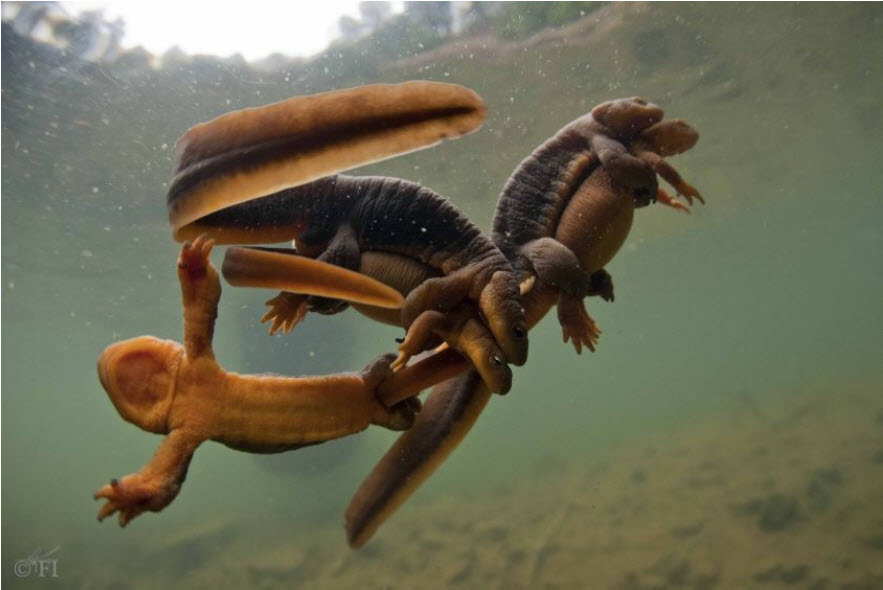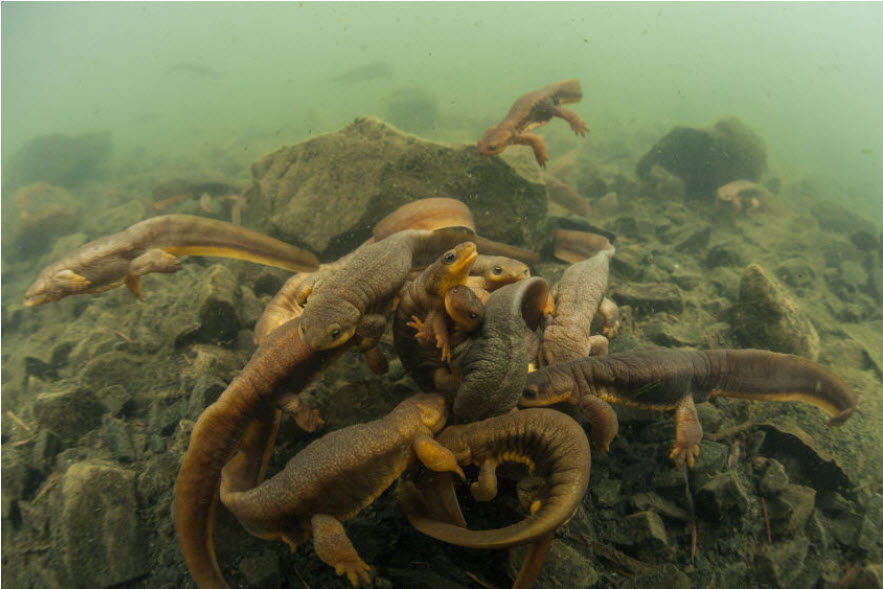Reproduction of the Rough-skinned Newt
Following winter in the spring adult
Rough-skinned Newts migrate to breeding ponds. Males arrive
ahead of the females, who only come to the pond in limited
numbers (Jones et al. 2002, B.C. Frog Watch Program 2013). As
discussed in Propper (1991), once both male and female newts
have arrived at the pond courtship begins and follows a series
of complex behavioral patterns that can be divided into three
separate stages: Pre-insemination, insemination and
post-insemination. Pre-insemination includes the displayed
behaviors that lead to attempted reproduction. Insemination
includes the behaviors seen during the fertilization of a
female’s eggs and post-insemination includes the behaviors seen
after Insemination (Propper 1991).
The pre-insemination stage is begun by a male newt when he
captures a female newt in a position that is known as dorsal
amplexus. A visual representation of dorsal amplexus can be seen
in the picture on the right side of the page. A description of dorsal amplexus is when a male newt
grabs a female so that his fore limbs are behind
 her
fore limbs and his hind limbs grab her in an area that runs
between the abdomen and cloaca (Propper 1991). From here the
male newt will move slightly forward and place his lower jaw on
her nose in order to rub her submandibular gland in what could
be described as chin rubbing (Propper 1991). In addition to the
nose rubbing, the male will also quickly flex both hind legs
together against the female newt’s abdomen and cloaca (Propper
1991). Around halfway through the hour’s long courtship the
female newt will choose to either move her head a small distance
from the male newts chin or will continue to remain unresponsive
to the male newts mating attempts (Propper 1991). If the male
receives this signal from the female newt he will begin the
insemination stage by releasing her. Males will almost never
attempt to fertilize a female without first receiving this
signal (Propper 1991). One reason that the Rough-skinned Newt
pre-insemination mating behavior lasts so long is that a female
uses this time to evaluate her potential mate for traits such as
endurance or competitive ability (Propper 1991). This selection
period allows for the female newt to be in control and mate with
the most reproductively fit male, which will allow for the
highest survival potential in her offspring (Propper 1991, Jones
et al. 2002). For the male newts this extra time allows him to
decide if a female has previously mated and will therefore be
unresponsive to any further mating attempts (Propper 1991).
her
fore limbs and his hind limbs grab her in an area that runs
between the abdomen and cloaca (Propper 1991). From here the
male newt will move slightly forward and place his lower jaw on
her nose in order to rub her submandibular gland in what could
be described as chin rubbing (Propper 1991). In addition to the
nose rubbing, the male will also quickly flex both hind legs
together against the female newt’s abdomen and cloaca (Propper
1991). Around halfway through the hour’s long courtship the
female newt will choose to either move her head a small distance
from the male newts chin or will continue to remain unresponsive
to the male newts mating attempts (Propper 1991). If the male
receives this signal from the female newt he will begin the
insemination stage by releasing her. Males will almost never
attempt to fertilize a female without first receiving this
signal (Propper 1991). One reason that the Rough-skinned Newt
pre-insemination mating behavior lasts so long is that a female
uses this time to evaluate her potential mate for traits such as
endurance or competitive ability (Propper 1991). This selection
period allows for the female newt to be in control and mate with
the most reproductively fit male, which will allow for the
highest survival potential in her offspring (Propper 1991, Jones
et al. 2002). For the male newts this extra time allows him to
decide if a female has previously mated and will therefore be
unresponsive to any further mating attempts (Propper 1991).
A summary of the insemination stage described by Propper
(1991) is, once the signal is received by the male he releases
the female and moves forward over her head so that he is in
front of her and both are perpendicular. The female newt then
attempts to keep her head positioned by the male’s
cloaca while
he produces a spermatophore (a protein capsule with a
sperm-filled cap; Propper 1991, B.C. Frog Watch Program 2013).
Once the spermatophore is produced the male rotates on one of
his front limbs, away from the spermatophore. The female then
follows the male until her cloaca is near the spermatohpore. She
then moves back and forth until the spermatophore sticks to her
cloaca. Once the spermatophore has been successfully attatched,
the male turns quickly and captures the female once again in the
amplexus position. This is where the post-insemination stage
will begin (Propper 1991).
As the post-insemination state begins the pair will remain
inactive and potentially stay in amplexus for many hours. The
chances of the first mating attempt being successful are very
high in Rough-skinned Newts; however, the behavior of post
amplexus allows the male to attempt another insemination if he
believes the first was unsuccessful (Propper 1991).
Post-amplexus can also act as a unique strategy to prevent
competition from other newt sperm by acting as a physical
barrier against any future courtship by another male (Propper
1991). Once the breeding season has been finished most female
newts will not return to breed for another two to three years
(Gall et al. 2012).
The period between the fertilization and depositing of eggs
is about two to three weeks during which a female newt typically
does not mate again (Propper 1991). Once a female newt is ready
to lay eggs she moves around the pond and attaches single eggs
to different stems of available vegetation in an attempt to
scatter her eggs around the breeding area (B.C. Frog Watch
Program 2013). This behavior of egg scattering may actually be a
survival advantage for the species since adult newts show no
preference in the consumption of newt eggs including those of
its own species and since high numbers of adult newts can be
found during the breeding season the number of newt eggs could
be quickly consumed if they were not scattered or hidden (B.C.
Frog Watch Program 2013). Newt eggs typically hatch three to
four weeks after being placed in the water and the
larval form
that hatches carries out metamorphosis in either the upcoming or
the following summer, depending on the weather, to reach its
adult form (B.C. Frog Watch Program 2013). These new adult newts
then head onto land and do not return to breed until a few
mating seasons have went by. On average the Rough-skinned Newt
has a life expectancy in the wild of about twelve years (B.C.
Frog Watch Program 2013).
Like many other organisms there are some costs associated
with such a long courtship. One of these costs described by
Propper (1991) is the investment
of time. Investing so much time into one female greatly reduces
the total amount of females that a male can fertilize and thus
reduce the potential spread of his genetic traits. Generally the
model of spending only a little time with multiple females is
what most organisms do to maximize their
 reproductive potential;
however, this is not the case with the Rough-skinned newt. This
is because the sex ratios of the breeding ponds tend to always
be skewed toward males resulting in males having to fight over
the few available females. This can be seen in the picture on
the left side of the screen where multiple males are swarming
around only one or two females. If a male were to only spend a little
time on trying to mate with a female he would have a good chance
of not being able to mate at all due to a lack of female newts
that would be available. The male newt may leave that female and
never encounter another receptive female for the remainder of
the breeding season. This huge difference between female and
male numbers has driven Male newt behaviors toward spending
large amounts of time on courting only one female. Newts unlike
many other species also do not have to worry about the increased
predation rate that accompanies long courtships, since they are
highly toxic and only have one known predator which the species
Thamnophis sirtalis. Both the skewed sex ratio and toxic
compounds of the Rough-skinned newt allow for the species to
have long and successful mating attempts (Propper 1991).
reproductive potential;
however, this is not the case with the Rough-skinned newt. This
is because the sex ratios of the breeding ponds tend to always
be skewed toward males resulting in males having to fight over
the few available females. This can be seen in the picture on
the left side of the screen where multiple males are swarming
around only one or two females. If a male were to only spend a little
time on trying to mate with a female he would have a good chance
of not being able to mate at all due to a lack of female newts
that would be available. The male newt may leave that female and
never encounter another receptive female for the remainder of
the breeding season. This huge difference between female and
male numbers has driven Male newt behaviors toward spending
large amounts of time on courting only one female. Newts unlike
many other species also do not have to worry about the increased
predation rate that accompanies long courtships, since they are
highly toxic and only have one known predator which the species
Thamnophis sirtalis. Both the skewed sex ratio and toxic
compounds of the Rough-skinned newt allow for the species to
have long and successful mating attempts (Propper 1991).
Currently there is one major threat to the reproduction of
the Rough-skinned Newt. This threat is man-made and caused by
salt run-off from roads that run through fresh-water habitats,
leading to unnatural salinization (Hopkins et al. 2012).
Taricha
granulosa is at high risk from this problem because they are
amphibians. This means that their species has permeable
skin and eggs, that will because of the fundamental principles
of diffusion allow higher concentrations of salt into the body
than what is considered to be normal (Hopkins et al. 2012). In
an experiment on Rough-skinned newt eggs, the eggs showed that
with increasing concentrations of NaCl and MgCl2, the rate at
which the eggs hatched with developmental deformities or
perished increased greatly (Hopkins et al. 2012). The
deformities in newt hatchlings can show a lot of variety and
include deformities of the spine, limbs, and organs as well as
the formation of cysts (Hopkins et al. 2012). However, currently
the species is in no immediate danger of extinction and steps
can be taken to reduce salt run-offs from roads.